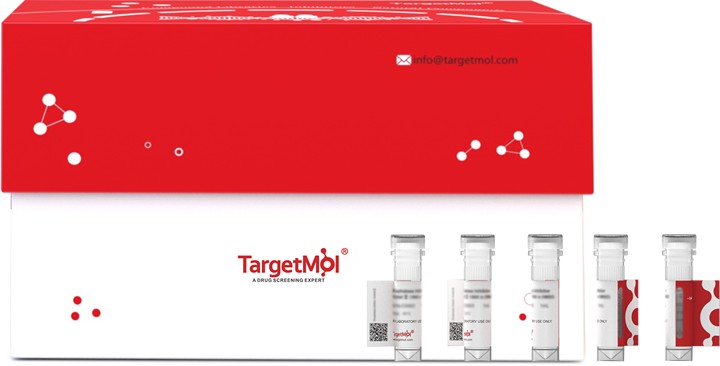- Remove All
 Your shopping cart is currently empty
Your shopping cart is currently empty
SECTM1 Protein, Human, Recombinant (His)
Secreted and transmembrane 1 (SECTM1), also known as K12, is a transmembrane and secreted protein with characteristics of a type 1a transmembrane protein of SECTM family. It is found in a perinuclear Golgi-like pattern and thought to be involved in hematopoietic and/or immune system processes. The human K12 protein has been shown to be primarily expressed in spleen, prostate, testis, small intestine, and in peripheral blood leukocytes. The K12 protein is expressed on the cell surface in such small amounts as to preclude detection. Alternatively, it may be that K12 on the cell surface is rapidly cleaved to generate a soluble K12 protein. Immunohistochemical analysis of peripheral blood cells shows that K12 is found in leukocytes of the myeloid lineage, with the strongest staining observed in granulocytes and no detectable expression in lymphocytes. May be involved in thymocyte signaling. It had been suggested a role for thymic microenvironment-produced K12 in regulation of thymocyte signaling and cytokine release, particularly in the setting of thymus pathology where IFN-gamma is upregulated such as myasthenia gravis. In addition, as a putative natural CD7 ligand, SECTM1/K12 may be responsible for the costimulatory role it plays in T cell activation.

SECTM1 Protein, Human, Recombinant (His)
| Pack Size | Price | Availability | Quantity |
|---|---|---|---|
| 100 μg | $600 | 7-10 days |
Product Information
| Biological Activity | Activity testing is in progress. It is theoretically active, but we cannot guarantee it. If you require protein activity, we recommend choosing the eukaryotic expression version first. |
| Description | Secreted and transmembrane 1 (SECTM1), also known as K12, is a transmembrane and secreted protein with characteristics of a type 1a transmembrane protein of SECTM family. It is found in a perinuclear Golgi-like pattern and thought to be involved in hematopoietic and/or immune system processes. The human K12 protein has been shown to be primarily expressed in spleen, prostate, testis, small intestine, and in peripheral blood leukocytes. The K12 protein is expressed on the cell surface in such small amounts as to preclude detection. Alternatively, it may be that K12 on the cell surface is rapidly cleaved to generate a soluble K12 protein. Immunohistochemical analysis of peripheral blood cells shows that K12 is found in leukocytes of the myeloid lineage, with the strongest staining observed in granulocytes and no detectable expression in lymphocytes. May be involved in thymocyte signaling. It had been suggested a role for thymic microenvironment-produced K12 in regulation of thymocyte signaling and cytokine release, particularly in the setting of thymus pathology where IFN-gamma is upregulated such as myasthenia gravis. In addition, as a putative natural CD7 ligand, SECTM1/K12 may be responsible for the costimulatory role it plays in T cell activation. |
| Species | Human |
| Expression System | HEK293 Cells |
| Tag | C-His |
| Accession Number | Q8WVN6-1 |
| Synonyms | secreted and transmembrane 1,K12 |
| Construction | A DNA sequence encoding the human SECTM1 (Q8WVN6-1) extracellular domain (Met 1-Gly 145) was fused with a polyhistidine tag at the C-terminus Predicted N terminal: Gln 29 |
| Protein Purity | > 97 % as determined by SDS-PAGE |
| Molecular Weight | 14 kDa (predicted); 23 kDa (reducing condition, due to glycosylation) |
| Endotoxin | < 1.0 EU/μg of the protein as determined by the LAL method. |
| Formulation | Lyophilized from a solution filtered through a 0.22 μm filter, containing PBS, pH 7.4. Typically, a mixture containing 5% to 8% trehalose, mannitol, and 0.01% Tween 80 is incorporated as a protective agent before lyophilization. |
| Reconstitution | A Certificate of Analysis (CoA) containing reconstitution instructions is included with the products. Please refer to the CoA for detailed information. |
| Stability & Storage | It is recommended to store recombinant proteins at -20°C to -80°C for future use. Lyophilized powders can be stably stored for over 12 months, while liquid products can be stored for 6-12 months at -80°C. For reconstituted protein solutions, the solution can be stored at -20°C to -80°C for at least 3 months. Please avoid multiple freeze-thaw cycles and store products in aliquots. |
| Shipping | In general, Lyophilized powders are shipping with blue ice. |
| Research Background | Secreted and transmembrane 1 (SECTM1), also known as K12, is a transmembrane and secreted protein with characteristics of a type 1a transmembrane protein of SECTM family. It is found in a perinuclear Golgi-like pattern and thought to be involved in hematopoietic and/or immune system processes. The human K12 protein has been shown to be primarily expressed in spleen, prostate, testis, small intestine, and in peripheral blood leukocytes. The K12 protein is expressed on the cell surface in such small amounts as to preclude detection. Alternatively, it may be that K12 on the cell surface is rapidly cleaved to generate a soluble K12 protein. Immunohistochemical analysis of peripheral blood cells shows that K12 is found in leukocytes of the myeloid lineage, with the strongest staining observed in granulocytes and no detectable expression in lymphocytes. May be involved in thymocyte signaling. It had been suggested a role for thymic microenvironment-produced K12 in regulation of thymocyte signaling and cytokine release, particularly in the setting of thymus pathology where IFN-gamma is upregulated such as myasthenia gravis. In addition, as a putative natural CD7 ligand, SECTM1/K12 may be responsible for the costimulatory role it plays in T cell activation. |
Dose Conversion
Calculator
Tech Support

Copyright © 2015-2025 TargetMol Chemicals Inc. All Rights Reserved.


